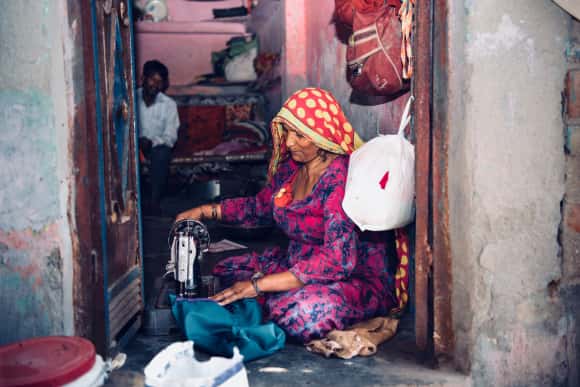
The addition of a new category “dependent contractor” in the status in employment classification of labour statistics should lead to better data and thus better national policies to benefit homeworkers: that is, sub-contracted home-based workers who are neither fully independent self-employed nor fully dependent wage workers. Firoza Mehrotra, strategy advisor to HomeNet South Asia, discusses the importance of the new category.
What is meant by the term “Dependent Contractor” and where has it come from?
The term “Dependent Contractor” is an international term adopted at the 20th International Conference of Labour Statisticians (ICLS) in October 2018. A Resolution was passed at this conference to include a new meta-category of Dependent Contractors in the revised International Classification of Status in Employment (designated ICSE 18).
“Dependent contractors are workers who have contractual arrangements of a commercial nature (but not a contract of employment) to provide goods or services for or through another economic unit. They are not employees of that economic unit, but are dependent on that unit for organization and execution of the work, income, or for access to the market. They are workers employed for profit, who are dependent on another entity that exercises control over their productive activities and directly benefits from the work performed by them.”
Home-based workers’ organizations recognize that, for statistical purposes, homeworkers (sub-contracted piece-rate workers) will now come under this category. However, the term “Dependent Contractors” has caused concern among home-based worker organizations.
Why is there apprehension about it?
The unease is mainly because in many countries, including in India, homeworkers (sub-contracted piece-rate workers) are recognized by law as “workers” or “employees” and have many benefits they can claim, including the benefits of a social security fund, a pension, a minimum wage, and the right to raise disputes with the employer. So by categorizing them as Dependent Contractors, there is a danger of losing the gains that have been made in labour laws and all the benefits that they have now. Even in other countries that do not have such provisions, by categorizing homeworkers as “dependent contractors”, they may be denied the rights of workers.
However, a close reading of the definition above, clearly mentions that they are “workers”, even though the meta-category says “dependent contractor”. Dependent contractors are categorized under the higher-level grouping of “Dependent Workers” in the classification hierarchy based on authority, along with Employees and Contributing Family Workers.

What was the need or rationale to make this new classification of Dependent Contractor?
In the labour force statistics of most countries, all home-based workers are categorized only as self-employed, without making a distinction between the self-employed, own-account workers and the sub-contracted piece-rate workers. This, therefore, does not provide the complete and nuanced aspects of home-based workers. This new classification will help make the distinction between the two kinds of home-based workers.
While the term is certainly not ideal, it was agreed to in the face of stiff opposition from the employers’ lobby. The concept is that there is an intermediary category between fully independent self-employed and fully dependent wage-employed workers who are often misclassified as “independent”. If they are not classified as “dependent contractors”, the sub-contracted workers would end up being classified as self-employed in many countries, as they now are in India and some other countries’ statistical systems.
If we have separate statistics for the self-employed, own-account workers and the sub-contracted piece-rate workers, it will help in informing the policy debates and in appropriate programming. Though both categories have some common requirements, such as social security, they also require different policy interventions.
At a more macro-international level, this new categorization of “dependent contractor” has become essential, as this form of work is growing very fast, both in the developing and the developed countries, and statistics are needed to inform policy concerns about the use of contractors, transfer of economic risk from employers to workers, access to social protection, and trends in non-standard forms of employment. This category will facilitate analysis of the labour market, taxation implications, labour law, social security obligations, and more general social policy. An increased incidence of dependent contracting can be indicative of a deteriorating labour market or economy, where enterprises are sharing the economic risk more with the worker and/or workers are prepared to engage in the market in this manner due to a shortage of jobs with more secure or standard employment arrangements. This can also help to promote appropriate social protection for workers and to mitigate the detrimental effects when these forms of employment are used or misused.

What kinds of workers are included in the meta-category of “Dependent Contractor”?
In addition to sub-contracted piece-rate homeworkers, this new meta-category of dependent contractor will, for example, include hairdressers who rent a chair in a salon and whose access to clients is dependent on the salon owner; waiters who are paid only through tips from clients; vehicle drivers with commercial contracts to provide services organized by a transport company; and consultants working for corporations or government agencies. The group also includes the emerging group of workers in the so-called “gig economy”, who have been the subject of much recent academic, political, legal, and media discourse. Examples include vehicle drivers providing rides or parcel delivery services and home-based workers performing information-processing services, where organization of the work or access to clients is mediated through an internet application controlled by a third party.
Can we revise the definition for South Asia and other developing countries so that homeworkers are not categorized as dependant contractors, which can be misleading?
This is an international standard set by the International Conference of Labour Statisticians and is applicable across the globe. It will help make comparable assessments and analyze global, regional and national trends in the labour market, etc. It is better to follow global standards. As mentioned earlier, “dependent contractor” is a meta-category only for statistical purposes and it will be possible to further break this category down and extract data for homeworkers separately. This sub-category could be referred to as “homeworkers”.
Besides the definition of Dependent Contractor given above, para 37(a) of the Resolution passed at the 20th International Conference of Labour Statisticians, clearly states “Included among dependent contractors are dependent workers who do not have a contract of employment, and (a) are paid only by the piece or commission, and do not benefit from social contributions paid by the economic unit paying for the work……” All this fits in very well with our understanding of sub-contracted, piece-rate homeworkers. It may be noted that here the word used is “worker” and not “contractor”.
Another important point is that this categorization of “dependent contractor” is only for statistical purposes and does not in any way limit or determine the way in which government policy will address the concerns of these workers.
Further, internationally, homeworkers are covered by ILO Convention 177 on Home Work and are recognized as workers with all the rights that an employee enjoys. This needs to be highlighted at all times.

What can we as stakeholders do to support the inclusion and security of homeworkers?
All stakeholders (home-based workers’ organizations and networks, mainstream trade unions, development practitioners, statisticians and academics) can raise awareness about the term “dependent contractor” and the advantage in using it to get data on sub-contracted, piece rate homeworkers and for advocacy.
Statisticians and statistical systems can ensure data on “homeworkers” is captured as a separate sub-category under the meta-category of dependent contractor.
Governments can legislate, plan and programme for the security and empowerment of home-based workers using this data.
This was developed with inputs from WIEGO.
Para leer este artículo en español, vea aquí.
Pour lire cet article en français, voir ici.
Related Posts
-
Informal Economy Theme
-
Informal Economy Topic
-
Occupational group
-
Region
-
Language
